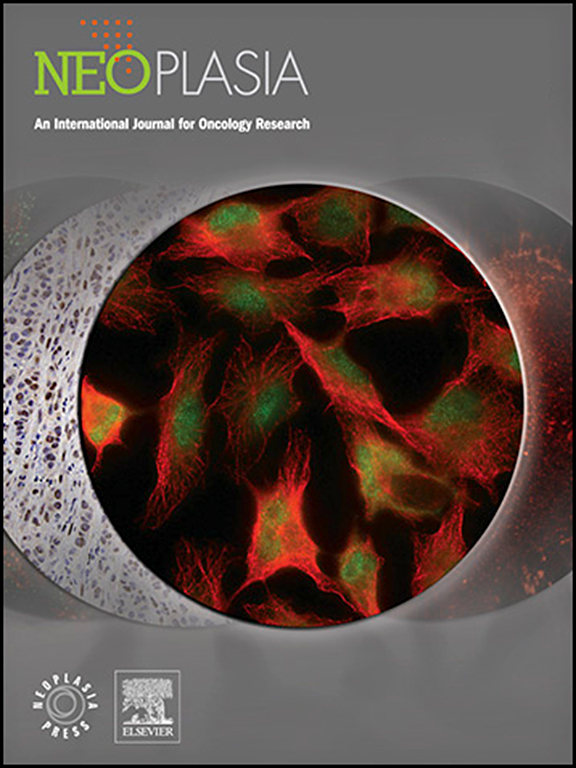PD-L1(+) tumor-associated macrophages induce CD8(+) T Cell exhaustion in hepatocellular carcinoma
IF 7.7
2区 医学
Q1 Biochemistry, Genetics and Molecular Biology
引用次数: 0
Abstract
The therapeutic efficacy of immune checkpoint inhibitors (ICIs) in patients with hepatocellular carcinoma (HCC) is profoundly influenced by the tumor immune microenvironment (TIME), where tumor-associated macrophages (TAMs) expressing programmed death-ligand 1 (PD-L1) serve as key modulators of immune suppression and tumor progression. Although PD-L1(+) TAMs have attracted increasing attention, their precise immunological functions in patients with HCC remain incompletely understood. In this study, we conducted an integrated analysis combining single-cell transcriptomics, spatial profiling, in vitro functional assays, and in vivo therapeutic modeling to clarify the role of PD-L1(+) TAMs in HCC. Single-cell RNA sequencing of tumor samples from patients with HCC (GSE189903) revealed that intratumoral PD-L1(+) TAMs were enriched for immune-related signaling pathways and expressed chemokines including CXCL9, CXCL10, and CXCL11. In vitro, GM-CSF–induced PD-L1(+) macrophages promoted CD8(+) T cell exhaustion, characterized by increased expression of TIM3 and suppression of cytotoxic molecules such as GZMB. Spatial analysis using multiplex immunofluorescence staining of surgical specimens from 113 patients with HCC demonstrated that close proximity between PD-L1(+) TAMs and CD8(+) T cells within tumors was an independent predictor of early postoperative recurrence and poor outcome. Moreover, in a murine orthotopic liver cancer model, the combination of anti–GM-CSF and anti–PD-L1 antibodies inhibited the differentiation of PD-L1(+) TAMs, reduced their contact with CD8(+) T cells, alleviated T cell exhaustion, and potentiated antitumor immunity. These findings highlight the critical contribution of PD-L1(+) TAMs to immune evasion in patients with HCC and support their therapeutic targeting as a strategy to enhance ICI responses.
PD-L1(+)肿瘤相关巨噬细胞在肝细胞癌中诱导CD8(+) T细胞衰竭
免疫检查点抑制剂(ICIs)对肝细胞癌(HCC)患者的治疗效果受到肿瘤免疫微环境(TIME)的深刻影响,其中表达程序性死亡配体1 (PD-L1)的肿瘤相关巨噬细胞(tam)是免疫抑制和肿瘤进展的关键调节剂。尽管PD-L1(+) tam引起了越来越多的关注,但它们在HCC患者中的确切免疫功能仍不完全清楚。在这项研究中,我们进行了一项综合分析,结合单细胞转录组学、空间分析、体外功能分析和体内治疗模型,以阐明PD-L1(+) tam在HCC中的作用。肝癌患者肿瘤样本(GSE189903)的单细胞RNA测序显示,肿瘤内PD-L1(+) tam富集免疫相关信号通路,表达趋化因子包括CXCL9、CXCL10和CXCL11。在体外,gm - csf诱导的PD-L1(+)巨噬细胞促进CD8(+) T细胞衰竭,其特征是TIM3的表达增加和GZMB等细胞毒性分子的抑制。对113例HCC患者的手术标本进行多重免疫荧光染色的空间分析表明,肿瘤内PD-L1(+) tam和CD8(+) T细胞的密切接近是术后早期复发和预后不良的独立预测因子。此外,在小鼠原位肝癌模型中,抗gm - csf和抗PD-L1抗体联合使用可抑制PD-L1(+) tam的分化,减少其与CD8(+) T细胞的接触,减轻T细胞衰竭,增强抗肿瘤免疫。这些发现强调了PD-L1(+) tam对HCC患者免疫逃避的重要贡献,并支持其治疗靶向作为增强ICI反应的策略。
本文章由计算机程序翻译,如有差异,请以英文原文为准。
求助全文
约1分钟内获得全文
求助全文
来源期刊

Neoplasia
医学-肿瘤学
CiteScore
9.20
自引率
2.10%
发文量
82
审稿时长
26 days
期刊介绍:
Neoplasia publishes the results of novel investigations in all areas of oncology research. The title Neoplasia was chosen to convey the journal’s breadth, which encompasses the traditional disciplines of cancer research as well as emerging fields and interdisciplinary investigations. Neoplasia is interested in studies describing new molecular and genetic findings relating to the neoplastic phenotype and in laboratory and clinical studies demonstrating creative applications of advances in the basic sciences to risk assessment, prognostic indications, detection, diagnosis, and treatment. In addition to regular Research Reports, Neoplasia also publishes Reviews and Meeting Reports. Neoplasia is committed to ensuring a thorough, fair, and rapid review and publication schedule to further its mission of serving both the scientific and clinical communities by disseminating important data and ideas in cancer research.
 求助内容:
求助内容: 应助结果提醒方式:
应助结果提醒方式:


